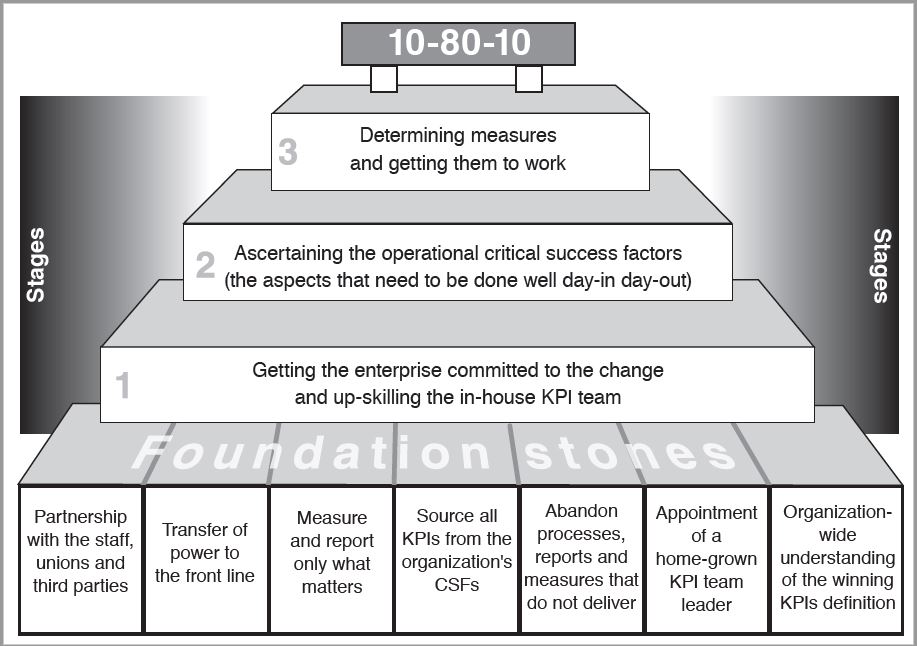Your cart is currently empty!
An overview of how to generate KPIs for your organisation (a three-stage process)
Exhibit from David Parmenter’s Key Performance Indicators (4th Edition)
An overview of how to generate KPIs for your organisation (a three-stage process)
By David Parmenter

Many organizations that have operated with key performance indicators (KPIs) have found the KPIs made little or no difference to performance. In many cases this was due to a fundamental misunderstanding of the issues.
Organizations often begin to develop a KPI system by immediately trying to select KPIs without the preparation that is indicated in the three-stage implementation plan. Like painting the outside of the house, 50 percent of a competent job is in the preparation.
Establishing a sound environment in which KPIs can operate and develop is crucial. Once the organization understands the process involved and appreciates the purpose of introducing KPIs, the building phase can begin.
The implementation difficulties were first grasped by a key performance indicator manual developed by the Australian Government Department “AusIndustries”. This guide has adopted many of the approaches of the KPI manual, which was first published in 1996. The KPI manual was the first to recognize that:
- A project needs foundation stones. There were originally four, and these have now increased to seven.
- You need to invest resources to sell the change to senior management and the rest of the organization. This edition emphasizes the need to sell the change through the emotional drivers of the intended audience.
- The critical success factors are the key driving force behind performance measures. This has been further refined with the branding of operational critical success factors.
- KPIs are at the workface, improving operations benefiting the financial, customer, internal process, innovation & learning, Environment & community and staff BSC perspectives.
- Readers need templates to move forward swiftly. This edition continues the tradition of endeavoring to second-guess all the main templates a KPI project team would need.
The three stages of the Winning KPI Methodology are described in Chapters 4 to 11 in David Parmenter’s Key Performance Indicators (4th Edition) . This is a summary.
Stage 1: Getting the enterprise committed to the change and up-skilling the in-house KPI team
All major project implementations are deeply affected by the success or failure in leading and selling the change. Chapter 4, which outlines John Kotter’s model of leading change, emphasizes the importance of selling by the emotional drivers of the intended audience, and sets out the steps required in this stage.
The senior management team must be committed to developing and driving through the organization’s KPIs and any balanced scorecard that includes them. In addition, timing is everything. This project must find a suitable window where the senior management team will have time to commit to the change process. Chapter 5 outlines the steps required in this stage.
The success of a KPI project rests with trained home-grown staff who have been reassigned so that they are full time on the project. Chapter 6 covers the importance of selecting an in-house person to lead the KPI team and explains the reasons why an external recruitment to run the KPI team is doomed to fail.
Stage 2: Ascertaining your organization’s operational critical success factors
Critical success factors (CSFs) are operational issues or aspects that need to be done well day-in and day-out by the staff in the organization. Chapter 7 looks at the differences between CSFs and external outcomes, highlights the importance of the CSF by indicating that it is a missing link in management theory, explains that an organization has typically five to eight CSFs, shows how CSFs are the origin of all performance measures, and explains how an organization goes about ascertaining them. Chapter 12 covers case studies on CSF workshops and some common critical success factors and their likely measures.
Stage 3: Determining measures and getting the measures to drive performance
Many performance measures are created from a flawed process. Chapter 8 examines common reasons why organizations get their measures radically wrong and how to design appropriate measures. Chapter 9 outlines all the tasks that need to be performed during a performance measures workshop, the tidy-up process on the performance measure database, and how to select the KPIs and KRIs.
Chapter 10 looks at the reporting framework that needs to be developed at all levels within the organization and shows how KPIs are refined to maintain their relevance and a variety of reporting templates.
This information has been extracted from David Parmenter’s Key Performance Indicators (4th Edition) which is the highest rated KPI book on Amazon.
Purchase my latest implementation guides which are currently on sale:
How to implement winning KPIs (180 page Whitepaper + electronic templates)
Finding your Organization’s Critical Success Factors – implementation guide (Whitepaper 115 pages+ electronic templates)
and buy the Database of Measures and Associated Success Factors 4th Edition
